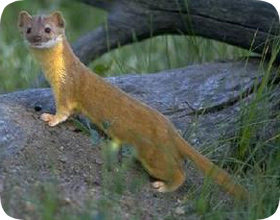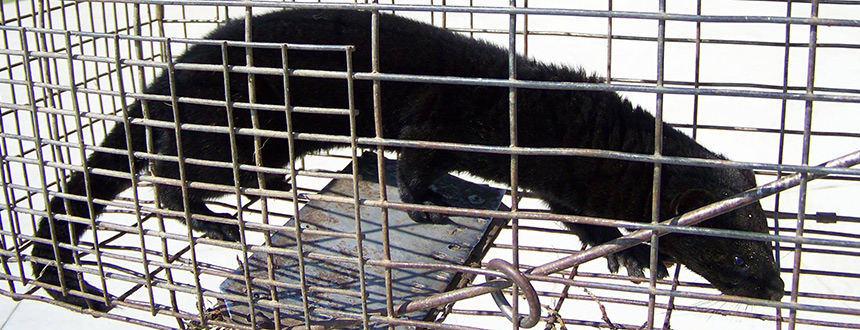-
info@aaanimalcontrol.com
Call us for help in your town
Humane Wildlife Education
How to Get Rid of Weasels or Mink
 These animals aren't commonly a problem for people, but like all animals, conflicts do sometimes occur. Living close to a body of water usually means that you are more likely to get mink in the area, and they can
cause mischief. A more serious problem is and weasels on your property. That can be a problem if you keep farm animals such as chickens because they will be the target to the weasel, who will often kill more than it
needs, just because that's it's nature. Mink also sometimes kill animals of value, such as chickens, although the mink usually will hunt game birds like ducks.
These animals aren't commonly a problem for people, but like all animals, conflicts do sometimes occur. Living close to a body of water usually means that you are more likely to get mink in the area, and they can
cause mischief. A more serious problem is and weasels on your property. That can be a problem if you keep farm animals such as chickens because they will be the target to the weasel, who will often kill more than it
needs, just because that's it's nature. Mink also sometimes kill animals of value, such as chickens, although the mink usually will hunt game birds like ducks.
Need weasel removal in your hometown? We service over 500 USA locations! Click here to hire us in your town and check prices - updated for year 2020.
Biology And Feeding Patterns Of Mink And Weasels
In order to get rid of minks or weasels it makes sense to know what their feeding habits and biology are so that you can make the habitat not the most pleasant for them. The first and most important thing to understand is the biology of both the mink and weasels and how it can be used to assist you. They both have short legs and have medium sized bodies and males are usually larger than the females in both cases. They like to live in areas where there is some water and vegetation to hide in; that is why rivers and marshes are perfect for these animals. Both these animals enjoy stealing eggs from all species of birds and dining on snakes and small reptiles.
Their diet is what can make them a real pest especially for farmers. They are carnivorous so they will not hesitate to kill chickens or other game birds. They will also feed on small mammals such as deer mice, pocket gophers, insects, and in some cases squirrels and rabbits. Although they eat insects and ground birds this is done when other food sources are rare.

Reproduction And Removal Of Mink And Weasels
Mink and Weasels start their mating in the late winter to the early spring. That means that the female should give birth in either April or May. Gestation period is about 51 days. They tend to only have one litter a year and usually have anywhere from six to ten kits in the litter. They will leave the nest in about six weeks and have their own den in less than six months. The young will pair up and mate the following mating season at just a year old.
The long tailed weasel on the other hand has a different reproduction time. They breed in the summer months of July and August and it only takes 27 days for the young to be born. The one thing that is similar with both mink and weasels is that their young are not able to see the moment they are born. Their eyes actually can take 5 weeks to open and their teeth do not come out until week 4. Sex is not easy to tell when they are born in fact it may take a total of two months until the young's sex is evident.
Diseases Mink And Weasels Can Give To People
A concern any time that you have wildlife in or around your home is the threat of possible disease. Mink and Weasels do carry diseases that you should take note of, and although getting those diseases is rare you should keep them in mind in case bad luck strikes. The first thing to examine is the bites from wildlife. Mink and weasels can bite if they feel threatened. They carry bacteria in their mouth which means that they can give you a serious infection especially in cases when they draw blood because of a bite or a scratch.
Another problem with bites is that mink and weasels like most other land mammals can get rabies. This disease is recognized on these animals when they act aggressive towards humans or other animals. It is best to stay away from an animal displaying these signs as rabies if not treated is lethal. One of the most curious discoveries in the last few years was that Swedish veterinarians actually discovered that a mink carried an aggressive strand of the H5 flu virus (bird flu). The reason the mink probably acquired the disease is because in the wild mink will feed from wild birds. More studies will be done as to the chances of mink transmitting bird flu to humans.
How To Get Rid Of Weasels And Mink
Living close to a body of water usually means that you are more likely to get mink and weasels in your property. That can be a problem if you keep farm animals such as chickens because they will be the target to the mink which usually will hunt game birds like ducks. You may be thinking of building a fence around your property and the fence is usually effective but it has to be mink and weasel proof. That means that it should at least be 5 feet tall and use gauge wire and sheeting. Another good idea would be to put gasoline covered rags on the fence. Be careful not to use the gasoline rags in areas where people build fires.
If you are going to use traps then you have to dig a hole for them. Leaving them on the surface will usually make the traps less effective. If you are placing the traps near a river, then dig a hole for the trap and place the bait inside and use some water and foliage to make the trap seem like a place the mink and weasel will not be afraid of. Once trapped, you can release the animals far from your home.
SOME SPECIFIC WEASEL AND MINK AREAS OF INTEREST:
Safely Remove Weasels And Minks In Your River Beds
Weasels or minks in a river bed might not seem like it could pose any problems at first but the truth is if your children are playing there often or if you have small livestock nearby it can quickly become a bigger problem. These animals have no problems eating eggs from hens, the chickens themselves and taking other small animals. Their feces can pose dangerous threats by way of passing along many different kinds of diseases. Finally, if your pets or children accidently corner one they can receive a nasty bite that can easily become infected.
If you're looking to eliminate the problem there are a few things you should try. You can destroy their burrows or flood their tunnels. The problem with this is often the animals will get killed in the process. In many areas these animals are protected so you want to do what you can to keep from harming them. The best way to remove the animals safely is to trap and remove them far away from your home. Bait your trap with wet cat food, raw chicken or even eggs. Once you have them in the trap be very careful when removing them so you don't get bitten.
How To Get Rid Of Minks And Weasels In Your Chicken Coops
It is very true that both minks and weasels can cause quite a bit of problems in your hen house. They love to fee on eggs, young chickens and even adult birds. Their very presence can disrupt normally active laying hens and cause them not to lay eggs for fear of danger. There are a couple of things you can do to keep them out. The best thing to do is to start with excluding them from the house. If you don't already have a very sturdy fence protecting the chicken yard it's a good idea to get one. It's recommended that you sink the fence below the ground at least a few feet, preferably up to four.
Once you have a sturdy fence protecting the yard you will need to also make sure that you have a very secure coop as well. You'll want to make sure that the chicken coop itself is very secure. Take the time to walk around the parameter and check for any holes the animals could get in through. Remember they are very slim so can fit through even a tiny hole. Secure these areas carefully with wire mesh or metal plating. This should go a long way to keeping any problems from reoccurring.
Get Rid Of Weasels Or Minks In Your Barn
Having weasels or mink in your barn can cause a wide range of problems. They may steal eggs from your poultry or kill birds. They will get in feed bins and can cause the spread of disease among creating a terrible mess. They can make nests out of different items in the barn, destroying them along the way and disturb all of your livestock. You will want to clear them out and quickly.
Lucky for you these animals don't reproduce like rodents causing a population explosion so you should be able to get rid of them quickly if you're careful. First check for ways they are getting into the barn and close these off, preferably with metal or mesh so they can't chew back in. Keep all feed in bins they can't get into and secure livestock. Next you will want to set traps that have been baited with wet cat food or meat scraps. Make sure to handle the traps carefully to insure you don't get much of your scent on them and let them rest for a few days. Once you have the animal carefully remove and release it many miles away from any homes near a water source.
Get Rid Of Minks And Weasels In Your Garden
Minks and Weasels don't often pillage a garden for food as they tend to be slightly more carnivorous. If you live near a river bank you might find that these critters start venturing closer to your home. Generally speaking they will be doing this in search of a food source. They like to feed off of birds and their nests so if you are feeding birds and have a large population of them it's a good idea to stop for some time. In addition to stopping make sure to clean up all the feed so you don't have any stragglers or food available for the weasels to eat.
Keep your garbage tidied up so the animals don't have food scraps to feed off as well. You should also keep in mind they like shrubs, wood piles and clutter to move in so clean this up as well. Finally if this doesn't work then start setting live traps with beat scraps or wet cat food as bait. Be careful in handling the trapped animal as it will lash out trying to bite you. Remove it to an area with a water source that is not near any other homes. As a final result you may want to fence your garden remembering to sink the fence a few feet underground so they can't burrow in.








































